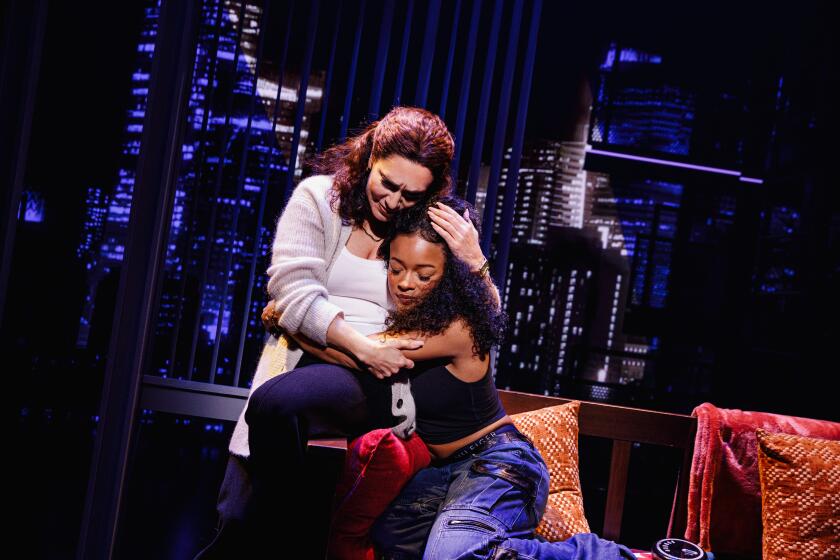Chamber music -- hip and, yes, packing ‘em in
SAN DIEGO -- Chamber music, all the rage a decade or two ago, has lost cachet of late. Presenters, trying to sell high-priced tickets for small ensembles in huge halls, now complain of empty seats. Doomsaying critics and consultants find no shortage of rowdy, hard-rocking young willing to decry the fey elitism of funereal gray-haired audiences snoring through dour, sour string quartets.
Naysayers -- say SummerFest, the annual August chamber music festival sponsored by La Jolla Music Society -- are said to be burying their heads in the sand. And La Jolla obviously has some pretty nice sand for the high-society patrons of this festival to use. But how, then, to explain Friday’s concert of new chamber music by Joan Tower and Marc Neikrug, along with reprises of recent festival commissions by Esa-Pekka Salonen and Chen Yi?
The concert was held not in the festival’s usual Sherwood Auditorium in tony La Jolla but in the acoustically lively Stephen and Mary Birch North Park Theatre in an urban, funky and gradually gentrifying San Diego district. The 730-seat reconditioned movie palace was practically full. The audience, casually dressed, included seniors in the center (the more expensive seats) and what looked like many hip North Park denizens on the fringes.
Onstage, several players were young and with it. The music was engaging. The performances were all terrific. The listeners were alert and enthusiastic. Violinist Cho-Liang Lin, now in his seventh year as the festival’s director, said in his opening remarks that the only way to keep chamber music alive is by continually replenishing it with new work. That was the point of the program. To doubt it, you’d have to argue with success.
Tower’s music began and ended the evening. First came “Wild Purple” for solo viola and “Big Sky,” a seven-minute piano trio commissioned for SummerFest 2000. The last piece was the premiere of “Trio La Jolla” -- also for piano, violin and cello but more than twice as long.
Tower’s work always ingratiates, but on first hearing (and all these pieces were new to me), I find it difficult to locate the substance. All three works could be characterized as relying on big gestures. Tower requires string players to dig in. The bow grapples with the string. The tone is thick, sumptuous. The piano in her trios adds a quotient of glitter. Her pieces often start out soft and build gradually, and that was the case with the new score, which also included a preponderance of solos for each of the three instruments. Lin, André-Michel Schub (piano) and Gary Hoffman (cello) -- all seasoned chamber players -- held the house in thrall.
Younger musicians -- Andrew Russo (piano), Joan Kwuon (violin) and Felix Fan (cello) -- played “Big Sky” with gusto, and they too were thrilling. Paul Neubauer was the violist for “Wild Purple.” Tower has a talent for brilliant color and fervor -- a lot of her music (especially orchestral, which is her forte) is wild purple. Neubauer dazzled, but he also supplied a hint of perfectly applied pathos.
Neikrug is best known as Pinchas Zuckerman’s accompanist and as the music director of the Santa Fe Chamber Music Festival. His renown as a composer comes third. His 1998 opera, “Los Alamos,” about the building of the bomb, got but a small fraction of the attention John Adams’ recent “Doctor Atomic” did; Google “Neikrug and Los Alamos” and you’ll get more hits about his chamber music series in the New Mexico town.
But “Ritual,” which had its premiere this summer in Santa Fe and closed the first half of Friday’s program, immediately made me want to hear the opera. The piece, written for the San Diego trio Real Quiet (Fan, Russo and percussionist David Cossin), displays many irresistibly savvy effects.
The ensemble is, I suspect, a bit hipper than the composer, but Neikrug has managed to produce something that sounds like a Santa Fe gamelan. The violin and piano writing -- not surprisingly for a pianist who has spent much of his career accompanying violin recitals -- is relatively conventional, but the way in which wide-ranging percussion motivates this 17-minute score is exciting, especially in the Native American feeling to the final, percussion-happy pages.
Lin also joined Neikrug for a performance of “Three Wine Pieces” for violin and piano. Each little movement is named for a fine wine. Take away the pretentiousness of the titles and the little movements themselves entertain.
One of the reprises was Chen Yi’s captivating and sonically extravagant 2004 “Chinese Ancient Dances” for clarinet and piano, played with spirit and panache by Los Angeles Philharmonic clarinetist Lorin Levee and Schub. This is happy music.
Another was Salonen’s “Lachen Verlernt,” an edgy solo violin piece premiered by Lin in 2002. Composed in the wake of Sept. 11, the piece takes its title (“Laughing Unlearned”) from a line in Schoenberg’s “Pierrot Lunaire.” The solo ultimately turned into a sketch for Salonen’s unsettling orchestra piece “Insomnia.” Lin’s magnificently virtuosic playing of the original has now become profound.
Laughing has been learned, and chamber music lives.
More to Read
The biggest entertainment stories
Get our big stories about Hollywood, film, television, music, arts, culture and more right in your inbox as soon as they publish.
You may occasionally receive promotional content from the Los Angeles Times.







